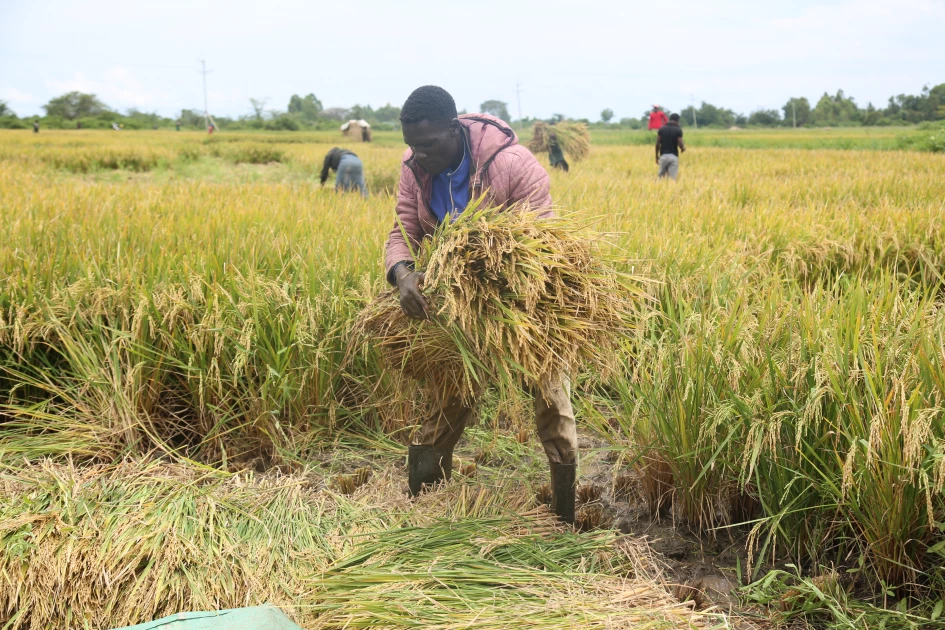Migori: How the Kuja irrigation scheme helped stop perennial floods and boost food security

A farmer in Migori's Lower Kuja Irrigation Scheme. Photo/ courtesy
The perennial floods along River Kuja normally happen during the March-May long rains and devastate residents of Nyora, Angugo, Sere, Modi, Kabuto and Kimai Yamek.
Teresia Achieng from Kabuto area in Nyatike constituency tells of their suffering from floods.
“I got married here in 1976, up to date have never experienced such an incident six years ago. It was during the long rains of March to May. I lost all my animals to the ranging floods that submerged our homestead. You could not access the compound. It was so traumatising,“ she recalls.
Achieng’ says that they had to move to higher ground to save their lives.
She adds; “It is very painful to watch helplessly as your wealth in terms of livestock which include goats, chicken and cattle drown in water.”
People like Achieng started fearing keeping livestock because they knew the next wave of floods will come and destroy their property and livestock.
However, the suffering of Nyatike residents was mitigated when the government, through the National Irrigation Authority (NIA) constructed the Lower Kuja Irrigation Scheme.
According to the government, the construction which involved the construction of water canals, tunnels, furrows and accessible roads was to help people start farming and also prevent floods.
First, the government carried out a baseline survey to determine the possibility and viability of having an irrigation scheme in Lower Kuja.
Daniel Atula, the Deputy General Manager, Operations and Irrigation Management Services at NIA confirms there was a baseline that showed some benefits to the local people.
“We found out that the project of Lower Kuja if it gets water from river Kuja and Migori, can produce food from 20,000 acres and it is the government plan to implement the project in five phases,” he says.
Five years after the baseline survey, the authority received funds and started construction to get water from River Kuja that could irrigate many acres of land nearby. After that, the water was available for the few farmers willing to start irrigating their farms.
Since then, the land under irrigation has been increasing up to the current 4500 acres, in Lower Kuja.
Atula shares; “The 4500 acres of land under irrigation in Lower Kuja irrigation has cost us Ksh.250 million. We are happy that the government has allocated us another Ksh.175 million in the 2023/2024 budget to put additional 2000 acres of land under irrigation.”
According to Atula, farmers are making double the profits from the farming of rice and other crops.
"The cost of production for one acre of rice is Ksh.72,000 and the farmer can harvest 40 bags of rice which can retail in the market for Ksh.180,000,” he says.
One of the beneficiaries of the scheme is Michael Otieno a farmer from Sere village in Nyatike. He shares that for a long time, his livelihood depended on fishing, but along the way there was a reduction of fish in Lake Victoria, forcing them to move deeper into Uganda or Tanzania side.
“Going to fish in Uganda or Tanzanian waters was risky because they could get arrested by marine officers from either of the countries for crossing the international boundary,” explains Otieno who now plants rice.
“I am assured of a bumper harvest after every three months. I can support my family through farming.”
Rice farming has also created job opportunities for the locals. Emily Odhiambo from Angugo village who was a housewife and is now employed in one of the rice farms, where she weeds and is involved in harvesting.
“I use the money from the rice farm to support my family such as buying clothes, food and paying school fees for my children,” she says.
Okeyo Oremo the chairman of Lower Kuja Irrigation recalls how bad the situation was during the March-May long rains. He says the schools, hospitals and churches in the flooded areas remained closed.
“Whenever it rained, floods would displace and destroy our properties leaving us poor. At times, we depended on relief food from the government,” he remembers.
The coming of the irrigation scheme changed everything. “Nowadays, floods are a thing of the past. People are going on well with their farming activities. They have plenty to eat and sell for extra income. They also no longer live in fear of floods.”
He adds that insecurity has reduced in those areas and many jobs created on the farms.
Atula adds that Lower Kuja rice irrigation is contributing to about 4 per cent of rice production in the country from around 4500 acres.
He reveals Gogo dam which is under construction will irrigate over 55,000 acres of land. He also explains that Lower Kuja irrigation scheme will be the second largest producer of rice after Mwea rice irrigation scheme.
susan.ndunda@royalmedia.co.ke
Want to send us a story? SMS to 25170 or WhatsApp 0743570000 or Submit on Citizen Digital or email wananchi@royalmedia.co.ke
Comments
No comments yet.


Leave a Comment